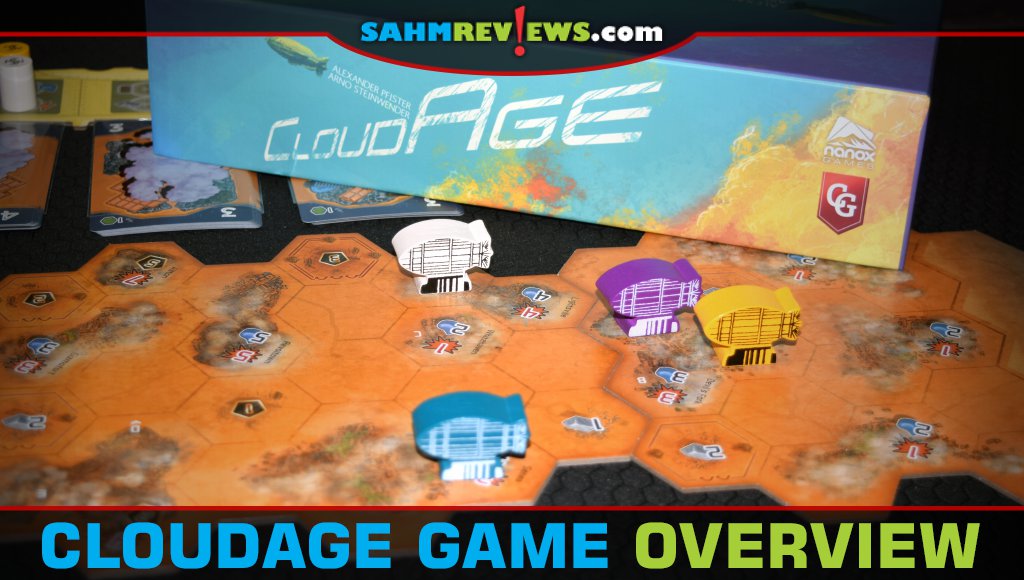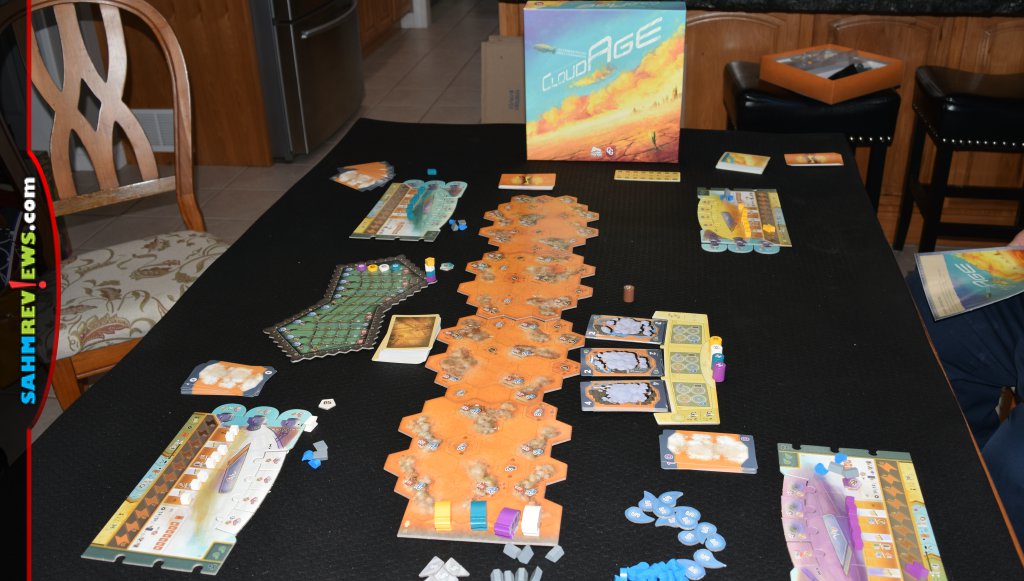CloudAge Board Game Overview

I’ve mentioned before that we get together regularly to game with some of our friends. Well, I need to be honest and admit that we’ve mostly been playing the same game(s) over and over lately. We wrapped up Gloomhaven a while back and are now dedicating a lot of our time together with our Frosthaven campaign. As much as we love it, it’s refreshing to play something different on occasion and that’s where games like My Father’s Work from Renegade Game Studios and CloudAge from Capstone Games come into the picture.

The premise of CloudAge is that a secret society set fire to oil production sites and burned down large forests causing the world to be destabilized. You travel by airship above the scorched earth in hopes of collecting resources. And here I am typing this just a few days past the destruction of a rogue spy balloon that traversed the United States. That’s kind of unsettling, but I digress. Let’s get our mind off that and set this game up! Place the main game boards together based on player count then the production board alongside.

Each player takes their personal airship board, airship, various marker types and navigation start cards. The City Board is populated with city cards utilizing the cloud sleeves to disguise their details. Create a general supply of resources within reach of players and place new growth tiles in the cloth bag. Mission, Story/Scenario and Project card draw piles are prepared and cards distributed based on your campaign or scenario. Everyone starts off with a basic airship, but it’s possible to upgrade it along the way.
A session of CloudAge lasts between six and eight rounds with each consisting of three phases: Production, Movement and Action. The overall object is to score the most points and you do that through actions like production, exploration, playing project cards, plant growth and improving your airship. The actions to take in each phase are indicated on the bottom of your airship board.

The phase begins by checking if the book action is active then (optionally) taking that action. These actions vary based on the story or scenario. Next it’s time to actually produce something. The production board and victory point tracker are the main part of this phase. Throughout the game, you’ll have opportunities to raise your position on the production board. Each round during this portion of the production phase, you can spend energy to collect water and possibly victory points. How much it costs and how much you earn is based on your position on that board.

The final step of this phase is for each player to reveal two cards from their navigation deck. The lower valued card will be used to collect energy or project cards. The higher valued card will be used during the next phase, Movement. Everyone starts with a base set, but there are opportunities to gain upgraded cards in lieu of other resources on the City Board.

In turn order, players will move their airships across the board to collect finds, mark routes and fight the militias. Your movement is limited by your navigation card, but can be augmented if you’ve upgraded your airship, have a solar panel or have movement points on project cards you’ve played. You can collect rewards by passing over them, but you may also be slowed by terrain. Your movement must end with your airship docked in a city space. You may opt to battle the militia in that city and earn the designated rewards. In order to win, you’ll need to have combat points higher than those of the city. Combat value is determined by the sum of your upgrades, project cards and combat on navigation cards. You’ll use one of your personal markers to leave on the city space, identifying that you’ve already been there and not able to engage in battle there again.

While you’ve already done a lot, you haven’t even gotten to the action phase yet. In player order, the active player places their drone on a city action and executes it. Options include one of the following: collecting resources, building or planting new growth. The inactive players will then place their drone on one of the remaining spaces. The card is removed from the sleeve and players earn the quantity identified on the card. What’s interesting is that the sleeve disguises the amount available so you won’t know what you’ve earned until the reveal.

If the active player chooses to build instead of collect resources then they may take two build actions and can upgrade their airship or play a project card from their hand. Inactive players may carry out one build action each. Upgrades to the airship provide better movement, combat and growth while project cards offer bonuses for victory points, instant effects or production advancements. Each player will have the opportunity to be the active player before the phase ends. The game continues over several rounds until the last cube on the round tracker is depleted. End-game victory points are calculated for upgrades, completed projects or missions and markers in the cities.
With multiple campaign and scenario options as well as a solo mode, CloudAge offers a lot of replayability. Check with your local game store for availability or pick up a copy online. Float over to Capstone Games‘ social channels (Facebook, Twitter, Instagram) to find out what other games are on fire!
What would you miss most if the earth’s terrain was destroyed?




